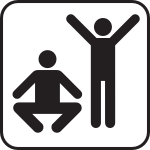 One important aspect of any human mission to Mars will be exercise. The trip to Mars will likely take a toll in terms of bone mass loss (spaceflight osteopenia) and muscle atrophy, despite our best efforts to counter these adverse effects. (In microgravity, neither nutritional supplements nor exercise nor hormones nor anything else has yet been proven to solve this problem.) On reaching Mars, the human crew will be weaker and more prone to broken bones than they were when they left Earth. In some respects, the reduced gravity on Mars (1/3 that of Earth’s) will make the adaptation back to a gravity environment easier. However, the reduced gravity is likely to allow for continued bone loss and muscle atrophy, unless the crew is diligent with an exercise regimen. (Exercise tends to be more effective in a stronger gravity field, since walking, jumping, and running result in stronger impacts to the body, stimulating bone and muscle growth.) While EVAs (Extra-Vehicular Activities) provide some opportunity for physical exercise, and certainly can be strenuous in very specific ways, they are unlikely to provide a full-body cardiovascular workout.
One important aspect of any human mission to Mars will be exercise. The trip to Mars will likely take a toll in terms of bone mass loss (spaceflight osteopenia) and muscle atrophy, despite our best efforts to counter these adverse effects. (In microgravity, neither nutritional supplements nor exercise nor hormones nor anything else has yet been proven to solve this problem.) On reaching Mars, the human crew will be weaker and more prone to broken bones than they were when they left Earth. In some respects, the reduced gravity on Mars (1/3 that of Earth’s) will make the adaptation back to a gravity environment easier. However, the reduced gravity is likely to allow for continued bone loss and muscle atrophy, unless the crew is diligent with an exercise regimen. (Exercise tends to be more effective in a stronger gravity field, since walking, jumping, and running result in stronger impacts to the body, stimulating bone and muscle growth.) While EVAs (Extra-Vehicular Activities) provide some opportunity for physical exercise, and certainly can be strenuous in very specific ways, they are unlikely to provide a full-body cardiovascular workout.
So our crew got thinking: what can we do in the way of exercise inside the Hab? We sought to satisfy multiple goals: daily exercise, without impacting our already busy schedule, in a space too small for all six to participate at once, and with enough variety to keep us engaged and motivated. We’ll aim for two exercise sessions per day, accommodating three of us at a time. LuÃs has volunteered to teach us kickboxing and capoeira. My Jazzercise instructor has offered to loan us an instructional video. In general, I expect that we’ll have a lot of fun with our exercise, and learn new things at the same time!
If you have any suggestions about other exercise ideas, please share in the comments (link at top of post).
I don’t have any suggestions, but I do have a bunch of questions: In a (mostly) closed system such as the MDRS, would one’s workout bombard others with body odors from fermenting perspiration? Is the air scrubbed well? Or do you become desensitized to it?
How much room is available for exercise? Is the interior as cluttered as, say, Mir was now that 80+ crews have been there before you?
Well, if you need high impact for bone density, I recommend all things small children do. Jump rope, running everywhere, punching things randomly and jumping off of every large object you see. I submit the “be a toddler” exercise program to NASA for consideration! 🙂
In all seriousness, have you considered specifically focusing on adding weights, increasing impact and similar things to specifically counteract the effects of low gravity and simulate earth gravity? In particular, how would you take equipment to increase weights (like ankle/wrist weights) on a spaceflight where surely mass would be extremely restricted? I guess you could adapt the weights with pockets to fill with whatever’s handy, like water, mars sand, plumbing supplies, anything that will be around! Kinda like the early American west settlers bringing only the metal parts of their tools with the intent to replace the wooden pieces when they arrived?
Jazzercise on Mars…I love it!
Jim, my understanding is that indeed the Hab is close quarters, and exercise-generated body odor could be a challenge! We’ll be experimenting to figure that out as well. I don’t think there’s any air scrubbing. The Hab itself is not airtight like a real Mars Hab would have to be. As for space for exercise, I think we’ll have to use our common room (mostly occupied by a table, which maybe we can move aside). That’s why we’re thinking of exercising in groups of 3.
Wendy, sometimes it seems it would be a lot of fun to just “be a toddler”! 🙂 And planning ahead for weights that could accommodate local mass fill is an excellent idea. I know there are travel weights designed to be filled with water. For Mars, rocks or other things might make the most sense. Thanks!